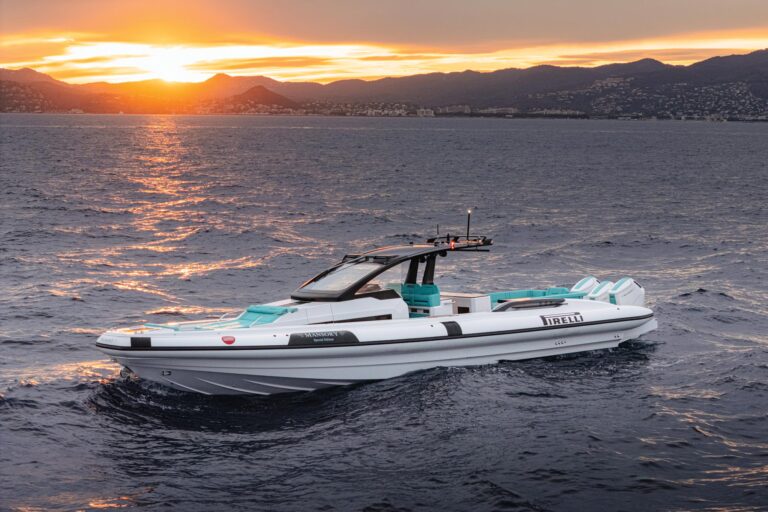Furuno’s new NX-300 is an excellent way to harness current Navtex technology, which provides immediate access to the latest marine notices and safety information. Some Navtex receivers receive and print incoming messages, but the NX-300 will store them in memory for recall and display at your command.
Navtex (short for Navigational Telex) is part of the GMDSS, a worldwide safety/communication system required for commercial vessels that’s finding its way into more and more fishing boats and pleasure craft. The system automatically receives, records, announces and displays a wide range of navigation safety messages. It alerts you with an audio alarm when it receives a warning message (navigation, weather or search and rescue), and gives you immediate knowledge of severe weather, sunken vessels, navigation hazards, extinguished or weak navigation lights and missing or damaged nav aids. The information includes the area up to about 400 nautical miles from each Navtex transmitter.
Furuno’s NX-300 has a built-in simulator mode that will help you understand how it works in about 10 minutes, even if the Navtex station serving your area is not transmitting at the time. If your first use is near shore and you happen to be far from the transmitter, reception may be poor during daylight. Reception at sea is available at all hours, with messages printed on the monochrome LCD in your choice of English, French, German, Italian, Spanish, Dutch or Portuguese. The screen is illuminated for night viewing, and it’s readable in sunlight.
The NX-300 is programmable for manual or automatic station selection. In automatic mode, the radio uses your vessel’s GPS-derived position to select the closest transmitting station. Because of Navtex’s message coding system, you can program the unit to receive only certain kinds of messages, blocking out, for example, ice reports and fisherman notices if you’re cruising the ICW in Florida. The unit also will let you monitor incoming signals by ear, sounding an alarm when certain codes are received.
The NX-300 stores a maximum of 132 messages containing as many as 28,000 characters. When the memory is full, the unit discards the oldest message to make room for the newest. The index displays messages in the order received, with the latest message at the top left of the screen. Messages numbered the same as others already stored in the memory are not saved in duplicate.
You can scroll the message list much like a Windows file list, using Up and Down keys to get to the message you want and pressing Enter to read it. Messages usually contain more information than the screen displays, so you have to manually scroll a line at a time or set the automatic scrolling, which has fast and slow speeds.
The NX-300 encourages installation in clear view of the helm by incorporating a navigation data page for display of navigation information from the connected GPS. Five user-definable data blocks are available on the navigation page and will typically show date/time, lat/lon, course and speed. Installation requires connecting the power wires to a 12-24 volt DC source, fitting either the E-field antenna (small whip) or the H-field antenna (no whip) and plugging in the antenna cable. If you connect the receiver to your GPS and to a computer, you’ll be able to download messages to the computer’s memory or directly to a serial input printer. Connection information appears in the owner’s manual and is available from an on-screen menu.
Price: $595.
Contact: Furuno U.S.A., (360) 834-9300; www. furunousa.com.
HOW NAVTEX WORKS
Navtex transmitters are along the coasts of nearly all countries. They transmit digital messages containing information about navigational warnings, weather, ice reports, searches and rescues, piracy and armed robbery. The system also sends information about the state of electronic navigation systems, including loran C and GPS. All Navtex transmitters use the same frequency: 518 kHz (just below the North American broadcast band). To avoid interference among stations, each transmitter in a given sea area is assigned a specific transmit time. Routine messages are usually sent every four hours, emergency messages when necessary.
U.S. Navtex coverage is reasonably continuous for the Atlantic, Gulf and Pacific coasts. In addition, transmitters are in Kodiak, Alaska; Honolulu; Guam and Puerto Rico. There may be some coverage gaps in the Southeast U.S., Alaska and Guam areas.
A summary of Navtex coverage in the United States is available at the Coast Guard’s Web site: www.navcen.usch.mil/marcomms/gmdss/navtex.htm. Navtex messages are coded to identify the sending station, the message subject and the message number. Regardless of how you program your receiver, it always will receive and store messages coded with the prefixes A, B, D and L. Navtex code letters include:
A-Navigational warning B-Meteorological warning C-Ice report D-Search & rescue (plus piracy and armed robbery) E-Meteorological forecast F-Pilot message H-Loran C message K-Other electronic navigation aid message (GPS) L-Navigational warning (additional) V-Notice to fishermen (U.S. only) Z-QRU (no message on hand)
Prefixes B and F aren’t normally used in the United States because the National Weather Service includes meteorological warnings in forecast messages, which are coded with the letter E. Coast Guard notices for mariners are coded with the letter A.









